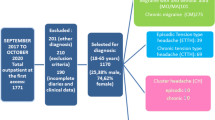Abstract
Olfactory hypersensitivity may occur during migraine attacks and has been found to be very specific for this form of headache. Aim of this study was to investigate if migraineurs with ictal osmophobia have particular clinical features comparing to patients without ictal osmophobia. We recruited 200 consecutive migraineurs. Other primary headaches comorbidity and migraine prophylaxis were exclusion criteria. Each patient was interviewed following a structured questionnaire including general features about migraine, depression and anxiety symptoms. Migraine triggers both spontaneously and selecting from a specific list. Allodynia during the migraine attack was measured using the Allodynia symptoms check-list 12 (ASC-12). Eighty four (42 %) patients are non-osmophobic vs. 116 patients (58 %) who are osmophobic. After a logistic regression analysis, pain intensity (OR 1.391; p = 0.008) and anxiety (OR 1.099; p = 0.047) were significantly higher while aura (OR 0.421; p = 0.028) is less frequent in osmophobic migraineurs. We found significant differences in clinical features of osmophobic patients in respect to non-osmophobic ones. Ictal osmophobia seems being related to a broader sensorial hypersensitivity that could lead to a more florid clinical presentation.
Similar content being viewed by others
Abbreviations
- ASC-12:
-
Allodynia symptoms check-list 12
- BMI:
-
Body max index
- GAD-7:
-
Generalized anxiety disorder 7-item scale
- ICHD-II:
-
International classification of headache disorders-2nd edition
- PHQ-9:
-
Patient Health Questionnaire 9-item scale
References
Maizels M, Aurora S, Heinricher M (2012) Beyond neurovascular: migraine as a dysfunctional neurolimbic pain network. Headache doi:10.1111/j.1526-4610.2012.02209.x. [Epub ahead of print]
Burstein R, Jakubowski M, Garcia-Nicas E, Kainz V, Bajwa Z, Hargreaves R, Becerra L, Borsook D (2010) Thalamic sensitization transforms localized pain into widespread allodynia. Ann Neurol 68:81–91
Headache Classification Subcommittee of the International Headache Society (2004) The international classification of headache disorders, 2nd edn. Cephalalgia 24(Suppl. 1):1–160
Zanchin G, Dainese F, Trucco M, Mainardi F, Mampreso E, Maggioni F (2007) Osmophobia in migraine and tension-type headache and its clinical features in patients with migraine. Cephalalgia 27:1061–1068
Baldacci F, Vedovello M, Ulivi M, Vergallo A, Poletti M, Borelli P, Cipriani G, Nuti A, Bonuccelli U (2013) Triggers in allodynic and non-allodynic migraineurs. A clinic setting study. Headache 53(1):152–160
Baldacci F, Vedovello M, Ulivi M, Vergallo A, Poletti M, Borelli P, Nuti A, Bonuccelli U (2013) How aware are migraineurs of their triggers? Headache 53(5):834–837
Lipton RB, Bigal ME, Ashina S, Burstein R, Silberstein S, Reed ML, Serrano D, Stewart WF (2008) American Migraine Prevalence Prevention Advisory Group. Cutaneous allodynia in the migraine population. Ann Neurol 63(2):148–158
Spitzer RL, Kroenke K, Williams JB et al (2006) A brief measure for assessing generalized anxiety disorder: the GAD-7. Arch Intern Med 166:1092–1097
Kroenke K, Spitzer RL, Williams JB (2001) The PHQ-9: validity of a brief depression severity measure. J Gen Intern Med 16:606–613
Sjöstrand C, Savic I, Laudon-Meyer E, Hillert L, Lodin K, Waldenlind E (2010) Migraine and olfactory stimuli. Curr Pain Headache Rep 14(3):244–251
Morillo LE, Alarcon F, Aranaga N, Aulet S, Chapman A, Conterno L et al (2005) Clinical characteristics and patterns of medication use of migraineurs in Latin America from 12 cities in 6 countries. Headache 45:118–126
Phan KL, Wager TD, Taylor SF, Liberzon I (2004) Functional neuroimaging studies of human emotions. CNS Spectr 9:258–266
Stankewitz A, May A (2011) Increased limbic and brainstem activity during migraine attacks following olfactory stimulation. Neurology 77(5):476–482
Bigal ME, Lipton RB (2008) Clinical course in migraine: conceptualizing migraine transformation. Neurology 71(11):848–855
Conflict of interest
In the past year, Ubaldo Bonuccelli has received fees for consultation from GSK and Eisai and for speeches from Novartis, GSK and Lundbeck. The remaining authors have nothing to declare.
Author information
Authors and Affiliations
Corresponding author
Rights and permissions
About this article
Cite this article
Baldacci, F., Lucchesi, C., Ulivi, M. et al. Clinical features associated with ictal osmophobia in migraine. Neurol Sci 36, 43–46 (2015). https://doi.org/10.1007/s10072-014-1903-5
Received:
Accepted:
Published:
Issue Date:
DOI: https://doi.org/10.1007/s10072-014-1903-5




